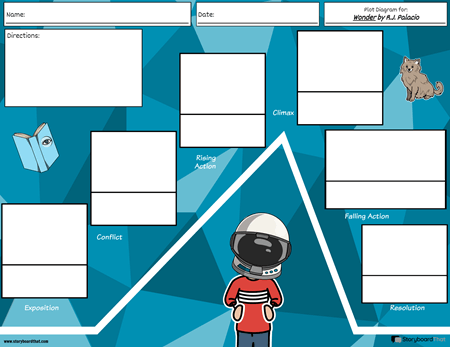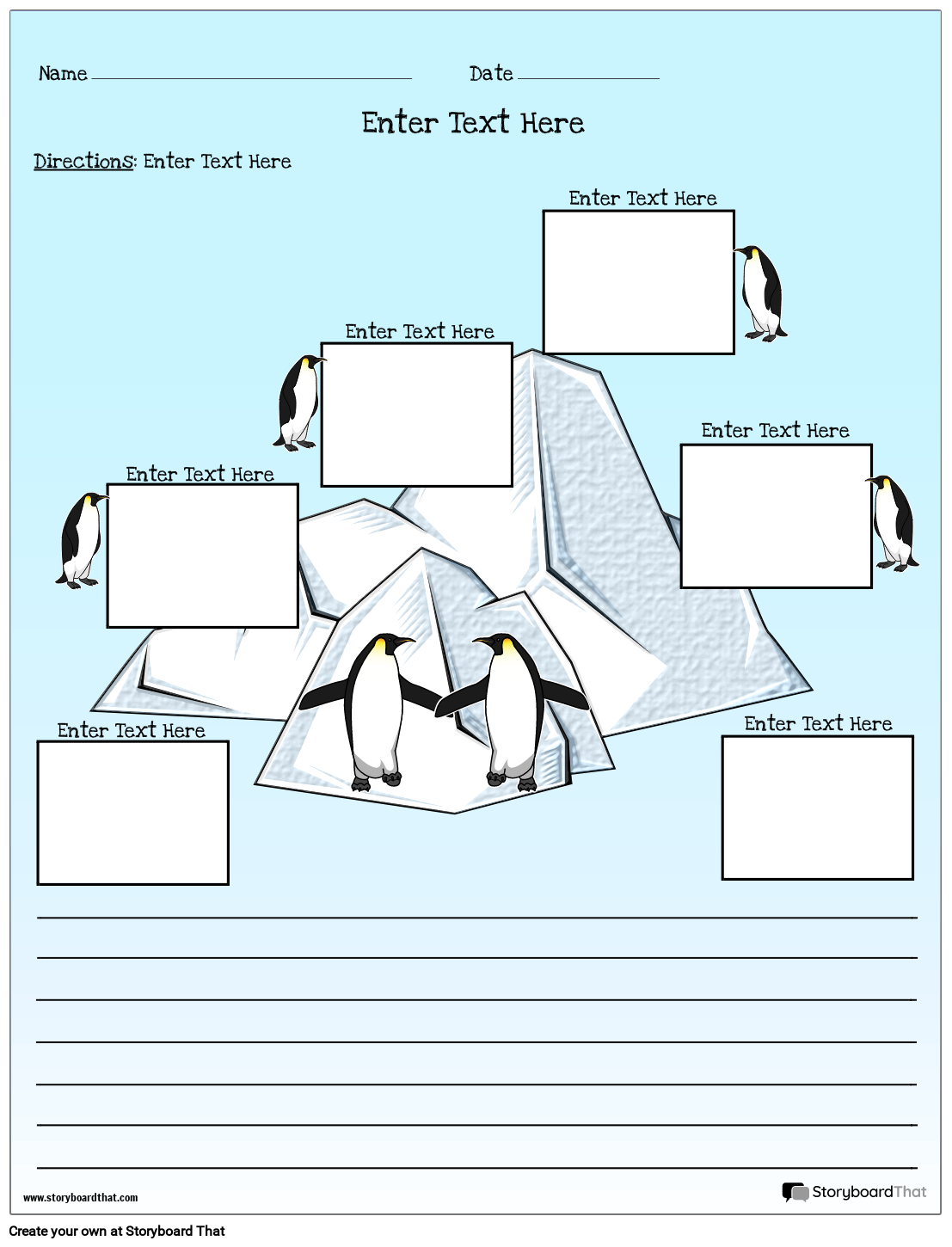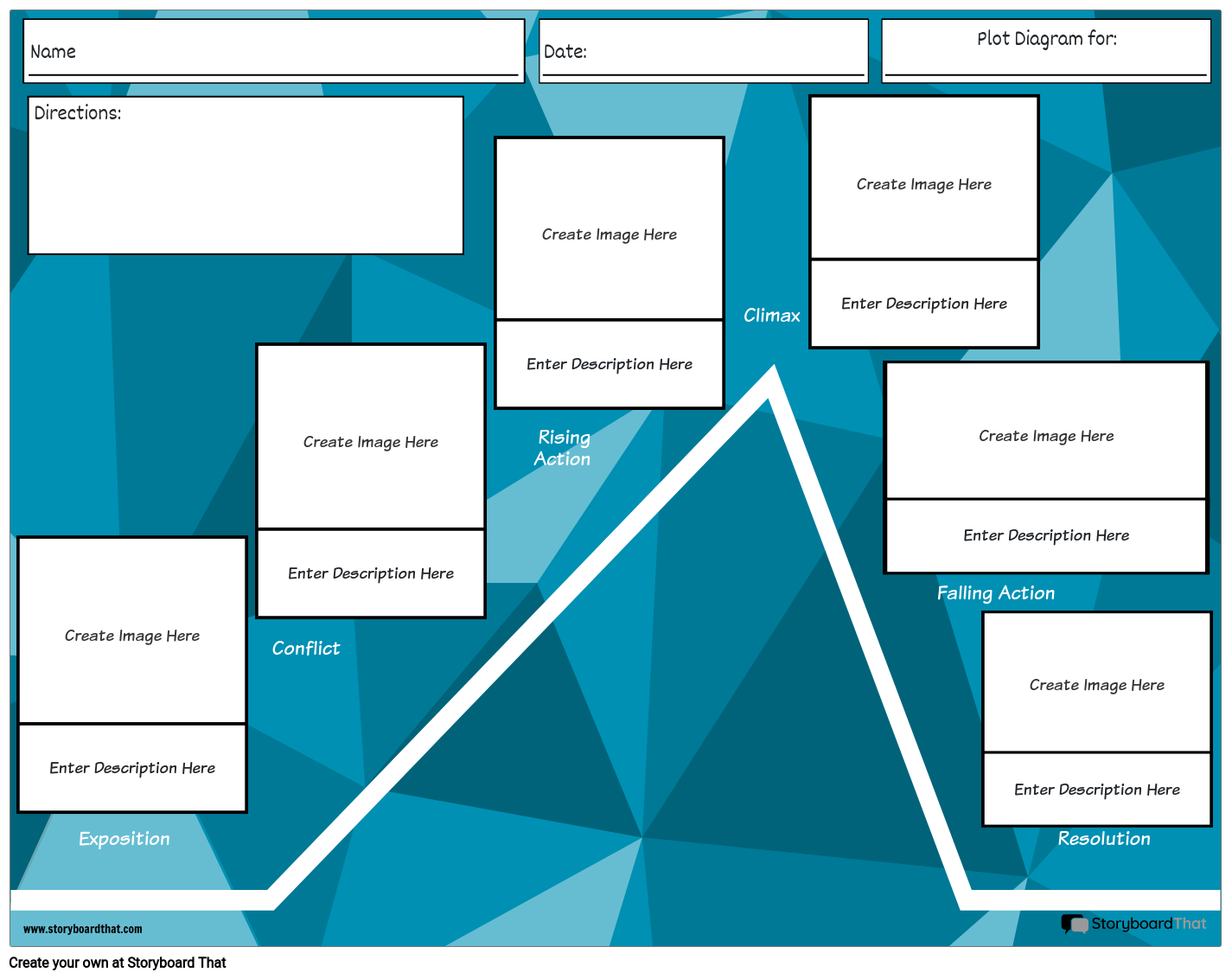Customize Plot Diagram Worksheets
If you're assigning this to your students, copy the worksheet to your account and save. When creating an assignment, just select it as a template!

Looking for an easy way to outline your narrative? Storyboard That's plot diagram templates help you plan out the main events, map character journeys, and visualize your story's structure. Our illustrated templates make creating a plot diagram quick and intuitive, perfect for writers, students, and educators.
What is a Plot Diagram?
A plot diagram, also known as a story mountain, plot mountain, or story structure chart, is a fundamental tool for authors and readers to understand the organization of a narrative. It outlines the five key components of a story's structure: exposition, rising action, climax, falling action, and resolution. Plot diagrams are invaluable for planning well-structured and engaging stories.
Each part of a plot diagram provides vital information about the progression and conclusion of a narrative. When viewed together, they offer writers and readers profound insights into the significant events that shape and define a story's development.
Why Are Plot Diagrams Important and How Are They Best Used?
Plot diagrams significantly aid reading comprehension and help students identify crucial themes and plot points within a story. Whether you're analyzing a book you're reading or planning a story you're about to write, plot diagrams are essential.
Utilizing a plot diagram template is a highly effective method for visualizing the development of characters and compelling plot points. To begin, identify the most important elements of your story and place them in the template's designated sections: "exposition," "conflict," "rising action," "climax," "falling action," and "resolution."
The exposition introduces readers to the central characters and setting. The conflict is the main problem in the story, and the rising action is critical, as it's filled with plot twists and revelations that propel the story towards its climax. This section should contain all major plot points leading to the narrative arc's turning point.
The climax is where central conflicts are resolved (or not). Following the falling action, conclude with an impactful resolution that demonstrates the crucial role of earlier plot points.
Finally, in the resolution section, plan any significant denouements that illustrate how character actions affect the story as a whole. By filling out a plot diagram template, you can easily keep track of your story's overview, helping you better analyze plots and symbols.
Plot Diagram Use Case Examples
Plot diagrams are versatile tools that work well with a wide range of genres and settings, appealing to readers of all ages. From suspenseful thrillers and mystical epics to heartfelt romances and touching coming-of-age stories, the possibilities are endless.
For instance, a crime mystery plot diagram could revolve around a detective solving a case filled with false leads and unexpected turns. Or, a story mountain for a search for lost treasure might explore themes of friendship and redemption as the protagonist unravels their past and battles dark forces to claim their prize.
Ultimately, the structure of a story arc blank template provides cohesion to any narrative, allowing ample room for character growth and intricate details that make stories captivating.
Plot Diagram Example Layout
Consider a detective trying to solve a mystery using the common core elements of a plot mountain. Here's how you could use each section of a plot line template:
- Exposition: Introduce the setting (e.g., a bustling city, a quiet suburb) and the detective, outlining their background and initial goals.
- Conflict: Introduce the main issue/problem in the story.
- Rising Action: Uncover clues and investigate suspects, with the detective gradually getting closer to solving the crime. This part builds suspense and develops the central conflict.
- Climax: The detective arrives at the grand reveal, assembling all the pieces of the puzzle. This is the turning point of the story.
- Falling Action: The detective wraps up their investigation, tying up loose ends and dealing with the immediate aftermath of the climax.
- Resolution: The detective successfully solves the case, bringing justice to those involved and restoring order.
Using a plot diagram example like this helps readers grasp story structure and provides writers with an easy-to-follow format for organizing their own ideas. With a plot diagram maker, writers can craft unique, interesting stories with a clear structure that captivate audiences worldwide.
Ways to Use a Plot Structure Diagram in Class
A plot diagram serves as an excellent visual aid in the classroom. Displaying a story diagram prominently on a wall or whiteboard can assist students with everything from book reports to presentations about film adaptations of classic literature.
How Plot Maps Help Students
Plot charts are invaluable for students as they illustrate how different parts of a story connect. By plotting out a story, students can visualize how all the pieces fit together. This is particularly helpful when writing papers or preparing presentations about a narrative.
It's also an effective way to learn about the structure of stories and novels, such as the 5-act story structure, enhancing students' understanding of literature. Plot development charts are beneficial for both fiction and non-fiction, providing a clear way to follow the progression of events.
Finally, by mapping out the story on paper, students gain a deeper understanding of characters and overarching themes. Seeing how each character's arc contributes to the overall narrative allows students to better appreciate the work's complexity. In essence, plot maps offer an organized and straightforward approach to understanding literature.
A better grasp of writing components can lead to higher grades on papers and tests, fostering a greater appreciation for literature.
How Plot Maps Help Teachers
Plot map templates are incredibly useful for teachers. Providing students with a visual aid like a plot line diagram breaks down stories into simple, easy-to-follow elements. This is especially helpful for younger students or those who struggle with comprehension.
Additionally, charting story events can help teachers identify plot holes or inconsistencies. This visual tool makes it much easier to pinpoint areas needing improvement and ensure every part of the story arc is covered.
Ultimately, plot maps are fantastic tools for teaching students how to create their own stories. By providing a basic template for plotting a story, teachers can help students understand writing's structure and flow. With guidance, students will be able to craft the most exciting parts of their narratives, leading to unique and captivating stories.
How Plot Maps Help Schools
Schools aiming to improve grade levels can benefit significantly from incorporating plot maps into their curriculum. They provide students with a visual tool that enhances their understanding of literature and helps them integrate what they've learned into their writing projects.
Students can also use plot diagrams to aid in writing their own stories and screenplays. This is a crucial skill, fostering critical and creative thinking. These skills are transferable, meaning even students not primarily interested in writing can benefit from using story maps.
Plot Diagram Templates vs. Hand-Drawn Diagrams
Using a plot structure diagram template with storyboard software offers significant advantages over hand-drawn diagrams. Digital tools make it easier to visualize story components and their relationships. Creating and editing a plot diagram graphic organizer is faster and more efficient, simplifying the grading process for teachers.
Hand-drawn plot structure diagrams can be more cumbersome and time-consuming, making it harder to perceive how narrative elements fit together. They also make grading more challenging due to potential messiness and poor alignment.
Effective Writing Techniques for Students
To become successful writers, students must practice effective writing techniques. One of the most essential is **outlining**. By creating a synopsis or a plot chart before writing, students can plan and organize their ideas, helping them stay focused on the overall structure of their essay or story.
Another key feature of good writing is editing. After completing a draft, students should review their work and make necessary changes, ensuring cohesion and strong structure.
Finally, students must recognize the importance of feedback. A second set of eyes can help identify areas for improvement, especially when writing stories and screenplays, as another person might spot plot holes or inconsistencies the student missed.
By utilizing story plot diagrams and these effective writing practices, students can enhance their writing skills and become better storytellers, leading to improved grades and future opportunities.
Fiction & Non-Fiction Writing With Plot Diagrams
Plot structure charts are excellent tools for both fiction and non-fiction writing. In non-fiction pieces, such as essays and research papers, plot diagrams help organize thoughts before writing. Outlining main arguments or problems beforehand makes crafting a cohesive piece much easier.
In fiction, plot diagrams can be used to brainstorm ideas and plan a story's structure. By using a story diagram template or a blank chart, writers can map out different scenes or events and see how they fit together, facilitating the creation of a fluid narrative that readers will enjoy.
Using Plot Diagrams in Different Types of Writing
While commonly used to help students understand books and write their own stories, plot map diagrams can also be applied to other types of writing:
- Creative Writing: A story plot worksheet can help students brainstorm and organize ideas for cohesive stories.
- Journalism: Plot structure worksheets aid journalists in planning their stories and ensuring factual accuracy and proper sequencing.
- Essays: Plot diagrams help students structure essays, ensuring logical organization of ideas.
- Screenplays: Plot diagrams are essential for screenwriters to plan stories and ensure logical progression.
- Business Writing: Plot diagrams can be used for presentations and proposals, helping writers present information clearly.
- Children's Stories: Plot diagrams assist in planning engaging children's stories with captivating characters.
- Formal Letters: Plot diagrams can help structure formal letters for clear and concise messaging.
- Emails: Plot diagrams can help writers organize emails, making messages easy to read and understand.
Plot Diagram Activities in Class
Once your plot diagrams are ready, numerous in-class activities can incorporate them:
- Have students read a story and plot the significant events on a plot pyramid template, reinforcing comprehension and memory of key points.
- Students can create their own plot diagram stories, teaching them story structure and creative writing skills.
- Use plot diagrams for assessment: ask students to create a narrative plot diagram of their own story or essay and grade based on organizational skills.
Plot Diagram Activities for Aspiring Writers
Aspiring writers can use plot diagrams to hone their craft, especially for short stories, novels, and screenplays, as they help plan plot structure.
Try reading a short book and using a plot diagram to break it down, understanding event flow and interconnectedness. Then, write a concise book synopsis outlining key events with fewer details.
You can also use plot diagrams to map out your own stories, staying organized and ensuring all ideas fit together. This also helps track writing progress, showing plot development and identifying areas needing more attention.
Plot Diagram Activities in the Workspace
Parts of a plot chart are also beneficial in the workspace for organizing tasks or ideas and ensuring proper order. They can illustrate relationships between departments or teams, ensuring everyone follows the same plan.
Finally, plot diagrams can illustrate project timelines, helping maintain organization and ensure on-time task completion.
Try a Storyboard That Plot Diagram Template
Creating a storyboard, graphic organizer, or other plot diagram project can seem daunting, but Storyboard That offers free plot diagram templates to streamline the process.
With dozens of storytelling templates to choose from, you'll quickly find something that suits your needs. Experiment with simple, efficient, creative, or fun options to find your perfect fit. Every template provides project structure, so explore different ones to see which aligns perfectly with your creative vision. Don’t forget that there are many free resources on our website, including line plot worksheets and pre-made templates, helpful questions to consider, and ideas for using the template in cross-curricular work
How to Make a Plot Diagram Worksheet
Choose One of the Premade Plot Diagram Templates
We have color, black and white, portrait, or landscape templates. Take a look at our plot diagram example for inspiration!
Click on "Copy Template"
Once you do this, you will be directed to the storyboard creator.
Give Your Worksheet a Name!
Be sure to call it something related to the topic so that you can easily find it in the future.
Edit Your Worksheet
This is where you will include directions, specific questions and images, and make any aesthetic changes that you would like. The options are endless!
Click "Save and Exit"
When you are finished with your plot diagram worksheet, click this button in the lower right hand corner to exit your storyboard.
Next Steps
From here you can print, download as a PDF, attach it to an assignment and use it digitally, and more!
Happy Creating!
Frequently Asked Questions about Plot Diagram Worksheets
What is a plot diagram?
A plot diagram is a tool used to map out a story and typically includes the exposition or conflict, rising action, climax, falling action, and resolution. A plot diagram is also known as a story mountain.
Why are plot diagrams important?
Plot diagrams aid in comprehension and retelling of the story. They help students learn to pick out the most important events in the story, including themes and plot points.
How do I use the plot diagram template?
To create a story plot diagram, simply choose a template and click on "copy template." Make the changes that you want to make in the storyboard creator, save, and exit, and you will have a printable plot diagram to use digitally!
What is a plot diagram template?
A plot diagram is a tool used to map out the main events and main characters of a story, helping authors stay organized and focused as they write. A plot diagram blank template is a stencil that is used as a reference to create a story.
How to use a plot diagram to make a story plot?
To use a plot diagram to make story plots, start by filling out the template with information about your characters, setting, and main events. Consider the questions provided on Storyboard That and use them to help guide your story. Once all the details are in place, you can use the template as a reference to write out the plot.
How to do a plot diagram?
To make your own plot diagram, start by downloading or drawing out the template. Fill out the character and setting boxes with relevant information for your story. Consider the questions provided on Storyboard That to help identify key elements of your plot. Finally, fill out each circle with a description of the main event in your story. Once you’ve done this, you can use the template as a reference to write out your plot.
© 2025 - Clever Prototypes, LLC - All rights reserved.
StoryboardThat is a trademark of Clever Prototypes, LLC, and Registered in U.S. Patent and Trademark Office
























